what type of wood native to hawaii is commonly used in making ukuleles?
Ukulele Buying Guide
There's never been a better time to go started playing the uke, given the hundreds of available models to choose from in every price range. Today you'll also observe lots of resources to help you learn the ukulele and develop your playing skills. We're committed to helping yous find your mode through the dizzying array of ukuleles on the market to that model which makes sense for your musical tastes and budget.
Sometimes thought of as a toy in the by, the adoption of the ukulele by major artists including Paul McCartney, Eddie Vedder, and Jason Mraz has given the little musical instrument newfound respect. Jake Shimabukoro'due south phenomenal mastery of the instrument has proven that in the right hands, the ukulele is capable of creating remarkably nuanced music.
The popularity of ukuleles shouldn't be surprising; with merely iv nylon strings they're easy to learn and play, and also easy on newbies' fingers, especially as compared to a steel-string acoustic guitar. In this guide we offering a brief history of the instrument and so requite you lot the information you lot need to choose the right uke to friction match your aspirations and upkeep. At Musician's Friend we carry a wide selection of ukes from very affordable starter ukuleles to the highest-quality instruments built to meet the needs of professional musicians.
Table of Contents
A Brief History of the Ukulele
Types of Ukuleles
Ukulele Shapes
Parts of the Ukulele
Ukulele Construction Methods and Wood
Specialty Ukuleles
Ukulele Tuning
Ukulele Accessories
Getting Started Playing the Ukulele
Summing Upward
A Cursory History of the Ukulele
Based on several small members of the guitar family, the ukulele was first adult in Hawaii during the 1880s when Portuguese immigrant cabinet makers fashioned instruments similar to those popular in their homelands. The ukulele speedily gained popularity in the islands thanks to the enthusiastic back up of King Kalakaua whose court often featured ukulele performances. Incidentally, the ukulele's proper name is derived from "jumping flea" in Hawaiian, and is based on the islanders' impression of the quick movements of players' hands on the fretboard. (By the style, our British cousins spell it ukelele.)
The ukulele's popularity spread to the United states when American songwriters began composing music with Hawaiian themes and sounds during the 1920s. Ukulele players proved popular on vaudeville stages, and the little musical instrument became strongly associated with the Jazz Age. The epitome of a raccoon-coat clad college pupil strumming on a uke became an icon of pop culture, and publishers began issuing songbooks for the ukulele. Taking notice of the fad, U.S. instrument makers such as Martin and Harmony began producing ukuleles. Cord bands of the era also brought the ukulele into their musical instrument lineups.
Although the presence of ukuleles in popular music continued from the 1940s through 1960s, in role thanks to the production of millions of cheap plastic ukes and Tiny Tim'southward 1968 hitting, "Tiptoe Through the Tulips." the musical instrument'south popularity declined. The uke staged a comeback in the 1990s, spurred in part by the immense popularity of a medley of "Over the Rainbow" and "What a Wonderful World" performed by Israel Kamakawiwo'ole that turned up in TV ads and movies. Since so, the ukulele's comeback has been reinforced by countless YouTube video performances, and by rock, pop, and folk performers who have taken up the instrument.
Types of Ukuleles
Most ukuleles fall into one of 4 standard sizes and tonal ranges: soprano, concert, tenor, and baritone.
| Ukulele Type | Scale Length | Overall Length | Tuning |
| Soprano (or Standard) | 13" | 21" | G4-C4-E4-A4 or A4-D4-F#4-B4 |
| Concert | 15" | 23" | G4-C4-E4-A4, A4-D4-F#iv-B4, or G3-C4-E4-A4 |
| Tenor | 17" | 26" | G3-C4-E4-A4, G4-C4-E4-A4, A4-D4-F#four-B4, or D4-G3-B3-E4 |
| Baritone | 19" | 30" | D3-G3-B3-E4 |
The original ukulele was the soprano. The smallest instrument in the family, it typically has a calibration length of nigh 13" and is nearly 21" in overall length making information technology ideal for smaller kids. The soprano's bright sound is the one we unremarkably acquaintance with ukes, and some manufacturers refer to their soprano models as"standard" ukuleles.
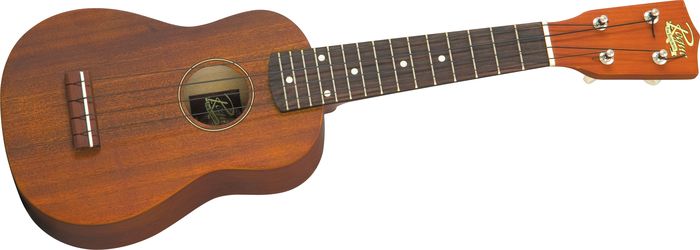
Despite its very low price, the Rogue Hawaiian Soprano Ukulele has excellent playability and makes a great introduction to the fun of playing a uke.
Next biggest is the concert ukulele with a scale of almost fifteen" and a 23" overall length. It produces somewhat deeper and louder output than the soprano, but still offers a sound similar to that of the soprano.
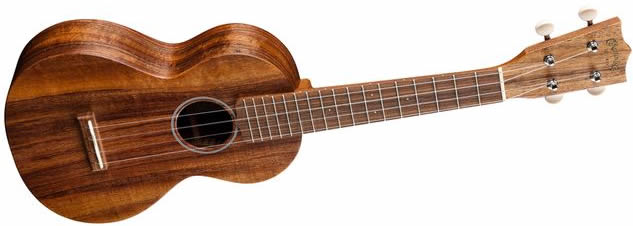
The Martin C1K Concert Ukulele is crafted in beautifully grained koa wood and typifies the superb build quality the company is renowned for.
The tenor ukulele has a deeper, more resonant sound resulting from its calibration of about 17" and length of about 26". Its roomier fingerboard can accommodate larger hands more easily.
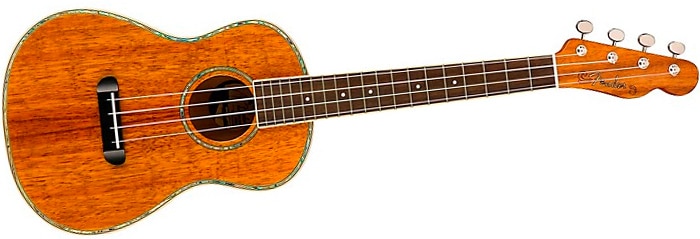
The MontecitoTenor Uke from Fender plays every bit beautifully equally it looks, and gets keen reviews from Musician's Friend's customers.
With its xix" scale length and an overall length of about 30", the baritone ukulele is capable of much deeper bass notes than its smaller brethren. It'southward tuned like the four highest strings on a guitar, making it a slap-up second musical instrument and easy transition for guitarists. We'll discuss ukulele tuning in more depth below.
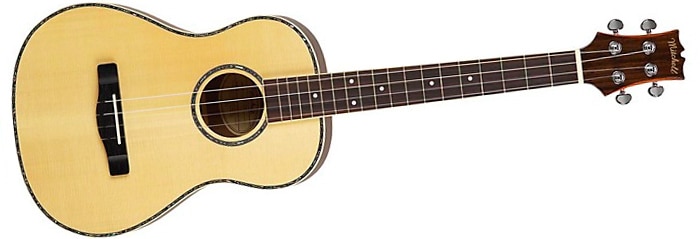
With its solid spruce top and rosewood body plus white binding and abalone rosette, the bold tone of the Mitchell MUB70S Baritone Ukulele is matched by its attractive cosmetics.
Top-Selling Ukuleles
Because of their affordable prices, ukuleles are popular with both gift buyers and musicians looking for a upkeep-friendly add-on to their drove. Here are some of the most popular ukulele models we sell:
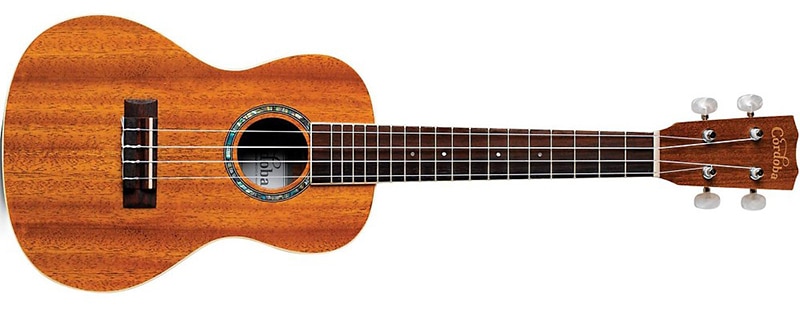
The hand-built nonetheless affordable Cordoba 15CM Concert Ukulele has all-mahogany construction for rich audio and sports deluxe touches like a fully spring torso and fingerboard.
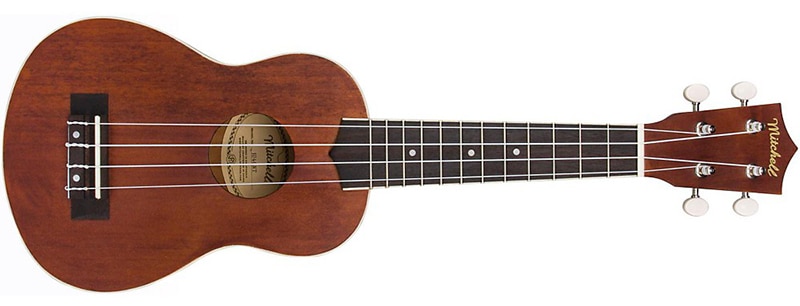
The Mitchell MU40 Soprano Uke is designed to assistance newbies go comfy with their first stringed musical instrument.
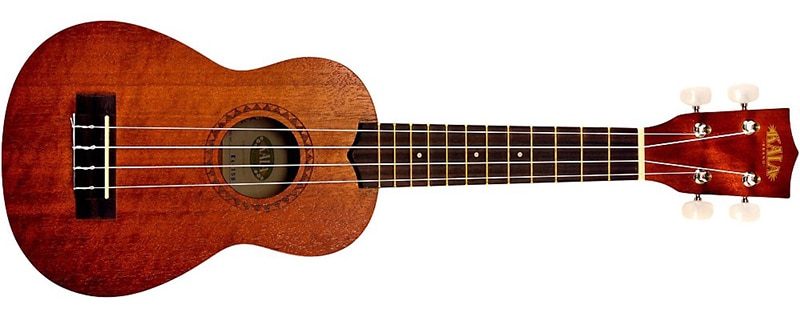
With its geared tuners and beautifully finished mahogany body, the Kala Soprano Uke makes an affordable selection that'll stay in tune nether heavy strumming.
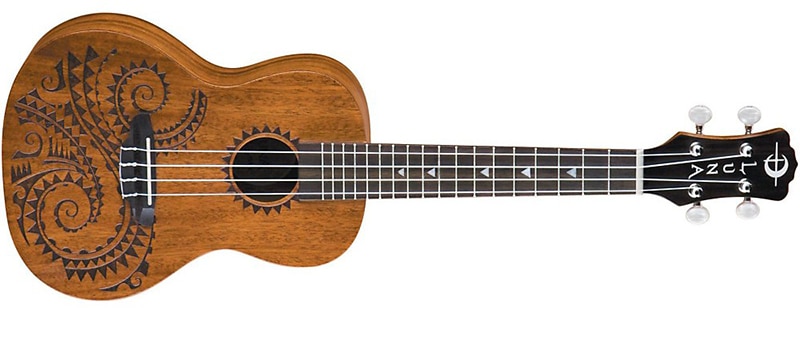
You'll be feeling that island vibe with the Luna Tattoo Concert Ukulele and its centre-catching looks inspired by traditional Hawaiian motifs.
Ukulele Shapes
Well-nigh ukuleles autumn into i of three basic shapes:
Guitar/figure-8: This is by far the most common shape amidst ukuleles. Resembling a guitar, the curved portion of the upper torso, referred to as the upper bout or shoulder, is commonly somewhat smaller than the lower tour. The narrow expanse between to the two bouts is called the waist. Some modernistic designs have cutaways in the upper bout that permit easier admission to the upper frets.
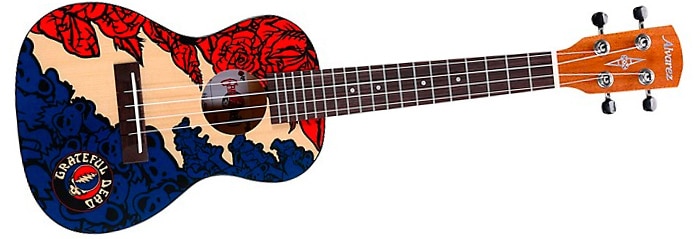
Pineapple: As yous might guess, the pineapple torso profile with its rounded back was a Hawaiian innovation first used on instruments made past the Kamaka Ukulele Company.
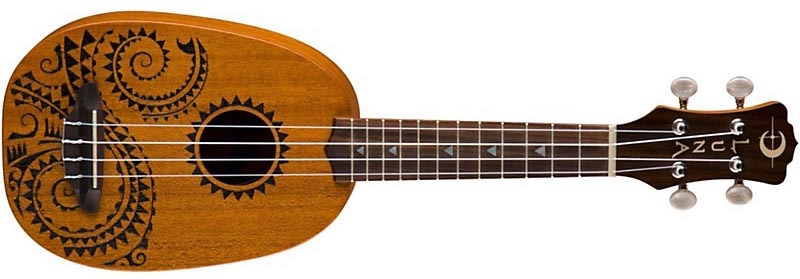
Boat Paddle: The name says it all; this contour is the least common shape among ukuleles.
Parts of the Ukulele
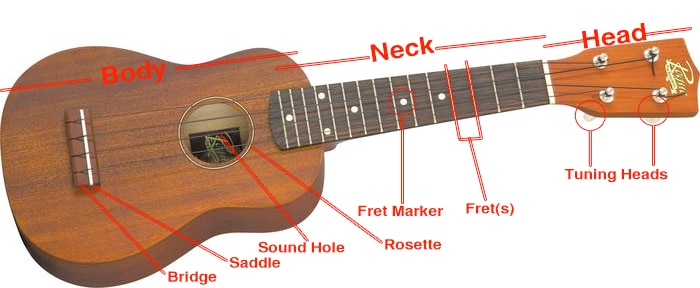
Headstock or head: Fastened to the neck, information technology holds the tuning pegs or tuning machines.
Tuning pegs: As well called tuning heads, tuning machines, tuning keys, or simply, tuners. They are geared mechanisms that concord the strings and are turned to adjust cord tension when tuning the ukulele.
Nut: Works together with the saddle to keep the strings in correct alignment.
Neck: It extends from the headstock to the body and supports the fretboard.
Fretboard: Besides chosen a fingerboard, it holds the frets and oft has position marker dots or other images to orient the player. The kickoff fret is nearest to the headstock.
Body: Consists of the top (sometimes chosen the sound board), dorsum, and sides. The top is primarily responsible for transmitting the strings' vibrations. Its audio hole helps to project the ukulele'due south output. Some sound holes have a decorative rosette.
Bridge: Mounts on the ukelele'south top and holds the saddle. The strings are are secured past knotting them on the tail terminate of the bridge.
Ukulele Construction Methods and Wood
Ukuleles are made using a diversity of woods and construction techniques. In that location are a few fabricated of synthetic materials and metal. We'll cover the about commonly used wood varieties here, but as you lot'll see when yous browse Musician's Friend'due south large ukulele selection, there are numerous variations and combinations of woods. Because a ukulele's sound is the result of many factors including its trunk shape and size, soundhole size, tuning, and type of strings, in that location is no one perfect ukulele forest whatever more than there is one perfect guitar wood.
Solid woods vs. laminated wood
Generally speaking, higher quality ukulele bodies are made with solid woods while more affordable models are fabricated with laminates—several thin layers of forest glued together and sometimes topped with attractively grained veneers. In some cases, ukulele bodies are fabricated with laminates while the top, which about strongly influences the instrument'southward tone, is made of a solid tonewood such as spruce or cedar.
Though not as resonant as solid-wood ukuleles, those made of laminates tend to be somewhat stronger and less prone to the splitting and cracking that can sometimes be an result in common cold and dry climates. Solid-wood ukuleles, like other stringed instruments, tend to mellow with historic period, producing richer tones. Laminates on the other hand volition sound the aforementioned throughout their life.
The Near Unremarkably Used Ukulele Tonewoods
Koa: This dense tropical wood that's native to Hawaii was the traditional woods of pick for ukuleles, and is still amongst the most popular for its beautiful grain patterns, wide range of colors, and balanced tone. Acacia, which is botanically related to koa, has similar properties.
Mahogany: Since it includes many varieties grown in various regions of the globe, it'south difficult to generalize near its tone, but mahogany generally imparts a darker, warmer tonality. Mahogany is often used for ukulele necks.
Spruce: With the recent popularity of ukuleles, many guitar builders have begun making them using the same wood used in guitar tops. A top choice of guitar makers, spruce's dense grain produces loud and vivid tones with lots of "zing."
Cedar: Beingness softer than spruce, it offers tones that are much more than mellow and round. It'southward a good choice for bringing out the lower notes produced by tenor and baritone ukuleles. Western red cedar is 1 of the nigh popular varieties.
Redwood: Tonally, redwood resides in the middle betwixt bandbox and cedar, offering much of the clarity of spruce with the warmth of cedar. Considering of overharvesting, redwood is deficient and expensive. Often redwood used in musical instruments is salvaged from quondam decks and furniture.
Rosewood: Commonly used on ukulele fretboards, this dense wood can also exist used for ukulele bodies. Aside from its hardness, rosewood's rich coloration and figuring can add to the ukulele's visual appeal.
Maple: Another wood often used in guitars, it has a dense grain that is sometimes attractively figured. Its hardness lends itself to ukulele bridges and fretboards.
Today, you'll discover ukuleles fabricated from dozens of wood varieties including ovangkol, cocobolo, nato, beech, myrtle, cherry, bubinga, mango, pau ferro, sapele, wenge, and many more.
Specialty Ukuleles
With the enormous popularity ukuleles accept recently gained, manufacturers have begun offer many variations and refinements on the original little "jumping flea." Here are some of the more common specialty ukes you lot'll encounter:
Acoustic-electric ukuleles: They accept an electronic pickup that detects the ukulele's vibrations converting them to electronic signals that are then transmitted via an on-board preamplifier to an external amplifier or sound system. Acoustic-electrical ukes are ideal for performers who play their ukelele in a band setting in which the little uke has to compete with amplified instruments. While a microphone tin can be used in such situations, feedback sometimes is a problem, and being tethered to a microphone tin can balk your stage presence and mobility. The preamp unremarkably includes both book and tone controls that help go the natural tone of your ukulele projected to the audition. A few acoustic-electric uke models include a USB output for recording straight to a USB device capable of recording.
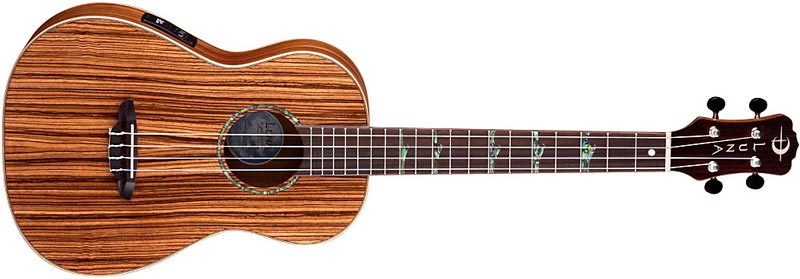
The hit zebrawood construction and abalone detailing of the Luna Baritone Acoustic-Electric Baritone Ukulele combined with an onboard preamp and pickup make it a great stage uke for apply with amplified bands.
Half-dozen-string and 8-string ukuleles: Usually based on a baritone or tenor ukulele calibration length, their compact size make them a worthy traveling companion and alternative to a travel-sized or ¾-scale guitar.
Hybrid Ukulele-like Instruments
Some manufacturers have begun building instruments that blur the lines between a traditional ukulele and other instruments such as banjos. "Banjoleles" incorporate a banjo-type head, rim, brackets, and resonator. Some are tuned the same manner as a ukelele, making them instantly familiar to a uke player.
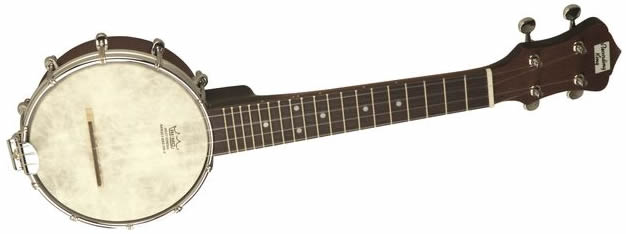
The Recording King U25 Banjolele combines the size and playing simplicity of a ukulele with the sound of a banjo for an altogether different musical experience.
Another hybrid is the resonator ukulele that borrows elements from traditional metal resonator guitars. Instead of traditional forest, the body may made partly or entirely of metal. A spun aluminum cone produces a distinctive, loud sound that tin can cutting through in dense mixes of audio-visual instruments.
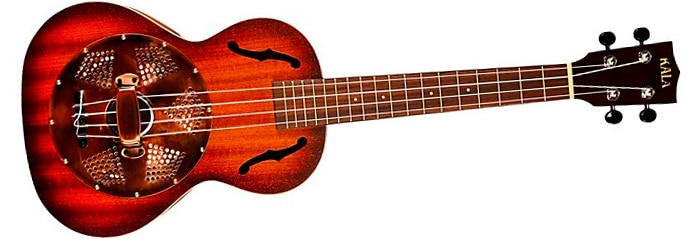
Ukulele Tuning
The three smaller ukuleles—soprano, concert, and tenor—are commonly tuned to the open- string notes G-C-Eastward-A. Baritone ukuleles are typically tuned to D-Grand-B-E—the aforementioned manner the four highest strings on a guitar are tuned. D-tuning is also a popular selection that some players feel brings out a "sweeter" sound on smaller ukuleles. D-tuning is A-D-F#-B. Other tunings are possible, and equally your skills develop you may want to experiment with them.
Use of alternate string types and arrangements can besides produce interesting musical variations.
Using an electronic tuner makes the process of getting your uke in tune much easier. Many such tuners have a manner that matches up with the strings on the ukulele. Clip-on models that attach to the headstock of the ukulele and sense its vibrations are very easy to utilize.
Go on in heed that new nylon strings tend to stretch, and so retuning more than frequently after buying a new uke, or putting on a new ready of strings is normal.
The quality of the tuning pegs or tuning machines on your ukulele can bear upon the ease with which you get in tune, and how well your uke stays in tune. Well-nigh metal tuning machines have fix screws on the buttons used to rotate the tuner. Tightening these periodically can help stabilize tuning.
Ukulele Accessories
As mentioned in a higher place, an electronic tuner makes tuning your ukulele a much easier process.
Also consider ownership a case or gig purse to ship your uke. It'll assist keep your ukulele safe from the perils of the road and protect your investment.
Some uke players prefer using a felt pick or standard guitar option as opposed to using their fingers, and you lot may want to experiment with the different sounds picks tin produce.
Strings can take a meaning bear on on the sound and playability of your ukulele. We offer a wide assortment of replacement nylon ukulele strings also every bit titanium, aluminum, and fluorocarbon sets to encounter just well-nigh anybody's needs.
Getting Started Learning to Play the Ukulele
With the explosion of interest in ukuleles, this is a swell time to become started cheers to all the resources now available to assist you lot master the instrument.
At Musician'southward Friend we offer a huge range of ukulele learning tools, instructional guides, and songbooks that will keep you lot happily strumming until y'all can practically smell the pineapples!
Music publishers have adapted some of the best-loved popular, folk, rock, country, and blues songs to the uke. Many include lessons that are tailor-made for absolute beginners also as ukulele tutorials for more advanced players.
There are also lots of simplified tab songbooks that show you how to play easy chord-based arrangements for songs you lot know and love.
Many of these songbooks and tutorials include online access to even more than resources, including ukulele how-to's, tuning tips, care and cleaning advice, and forums for ukulele students and players.
Summing Up
In the cease, choosing the right ukulele is near finding the one that works for you; a ukulele that's fun to play and to hear. So though yous now know more almost how ukuleles are built and what materials go into them, let your fingers and ears guide you to the right uke.
We want yous to be pleased with your ukulele purchase, and offering a 100% satisfaction guarantee and generous return policy then yous can gild your new ukulele with confidence.
Afterwards reading this guide, if yous're withal not sure what ukulele is correct for you, we invite you call to one of our friendly and knowledgeable Gear Heads.
Read How to Choose the Correct Strings for Your Ukulele.
Source: https://www.musiciansfriend.com/thehub/ukulele-buying-guide
0 Response to "what type of wood native to hawaii is commonly used in making ukuleles?"
Post a Comment